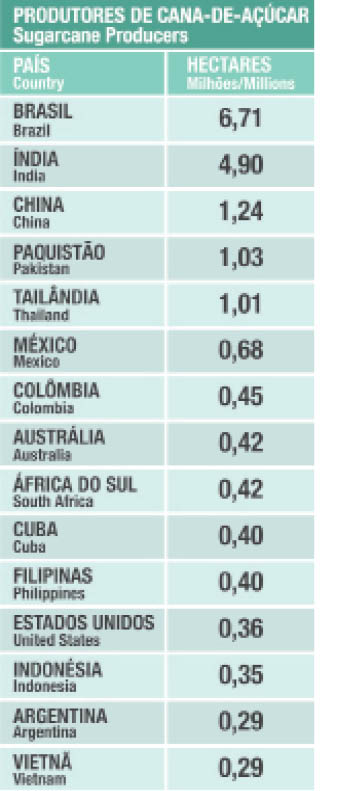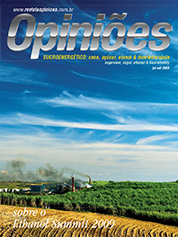José Goldemberg
Professor at the Electrotechnical and Energy Institute of the University of São Paulo
Op-AA-21
The limitations of first generation ethanol
A great effort is being made to research and develop the second generation production of ethanol using a variety of methods, foremostly enzymatic hydrolysis. The main reason for this is the fact that ethanol in the United States and in several European countries is produced from corn, beet and wheat, in direct competition with the production of food.
The expected increase in ethanol usage, resulting from governmental decisions in these countries, faces difficulties mainly due to the lack of expansion areas. Second generation technologies would resolve this problem by using any cellulosic agricultural products, such as wood, grass and even organic waste. The outlook for these initiatives being successful is quite promising, albeit many uncertainties still exist and a long way lies ahead before second generation technologies reach maturity and become commercially competitive.
Hence the importance of assessing the current limitations of ethanol production with first generation technologies, particularly from sugarcane. In 2008, Brazil produced 22.5 billion liters of ethanol, using 3.4 million hectares, which allowed replacing about 1.5% of the gasoline used in the world, mainly in the country itself, which replaced approximately 50% of the gasoline that would have been consumed.
The possibility of increasing this production – obtained from sugarcane – depends on two factors:
1. productivity gains that would allow the production of more ethanol in one same area, and
2. geographic expansion in Brazil and other sugarcane producing countries.
An analysis of available data shows that increasing ethanol production, following this route, by a factor of 10, i.e., replacing 10% of the gasoline used in the world, is not only possible but also likely.
Productivity gains: Sugarcane is a tropical plant, perennial, with a C4 metabolism, that captures 6% of the incident solar energy, amounting to a theoretical yield of 472 tons of sugarcane per hectare (or 219 tons of dry biomass per hectare).
This theoretical yield is not attainable in practice due to a variety of agronomical, environmental and physiological limitations, such as diseases, soil quality and the very characteristics of the existing varieties that contain varied sugar content. With all these limitations, the maximum yield achieved until now is about half the theoretical yield.
Sugarcane productivity, considering both the agricultural phase and the industrial processing phase (in which sugarcane is converted to ethanol), has grown about 4% per year since 1975; the number of liters produced per hectare increased from approximately 2,000 liters per hectare, in 1975, to 7,000 liters per hectare in 2005. This took place through the diversification and selection of the varieties used, which were only 6 in 1984 and have since increased to more than 500 in 2005. Additional gains could be achieved through genetic modifications. There is, therefore, the prospective of doubling current productivity.
Geographic expansion: The area used by sugarcane plantations destined for ethanol production in the country is 3.4 million hectares. A similar size area is used for the production of sugar.
The total cultivated area for sugarcane represents 10% of the area used for agriculture in the country; soya represents 27% and corn 18%. What is noteworthy, however, is that pasture lands cover 172 million hectares, more than twice the area used by agriculture, which totals 77 million hectares. It therefore becomes obvious that an environmentally safer means of expanding sugarcane plantations is by replacing pastures, rather than deforesting native forests. This is not only possible; it is actually what is happening.
Just to give an idea, the area dedicated to agriculture in the State of São Paulo grew from some 5 million to 8 million hectares, between 1970 and 2006, whereas pasture lands decreased from 12 million to 9 million hectares. To a considerable extent this expansion was due to sugar-cane. As a result, the density of cattle on pasture lands increased from 1.1 to 1.3 heads per hectare, which is still quite a low land occupation rate.
With the recently adopted eco-economical zoning implemented in the State of São Paulo, the expansion of sugarcane cultures complies with all the prerequisites to continue being acceptable from the environmental point of view. So there is actually enough room to expand the sugarcane culture in Brazil. The same takes place in all other tropical regions of the world. Sugarcane is produced in some 100 countries. The 15 main producers, responsible for 86% of the production, are listed in the Table.
The total occupied area, excluding Brazil, amounts to approximately 12 million hectares. If these countries were to follow the example of Brazil, dedicating half their output to the production of ethanol, this would increase the area around the world dedicated to ethanol, from the 3.4 million hectares being used in Brazil, to 9.6 million, thereby tripling ethanol production to almost 70 billion liters per year.
 Around the world, the area used for agriculture is of about 1.4 billion hectares and grows by 3 to 4 million hectares per year. To dedicate 1% or 2% of this area (14 to 28 million hectares) to sugarcane for the production of ethanol is an easily attainable target. Added to still possible productivity gains, as previously mentioned, it seems feasible and realistic to achieve a production of 200 billion liters of ethanol per year (about 10% of the world gasoline consumption), ten times more than what is produced today.
Around the world, the area used for agriculture is of about 1.4 billion hectares and grows by 3 to 4 million hectares per year. To dedicate 1% or 2% of this area (14 to 28 million hectares) to sugarcane for the production of ethanol is an easily attainable target. Added to still possible productivity gains, as previously mentioned, it seems feasible and realistic to achieve a production of 200 billion liters of ethanol per year (about 10% of the world gasoline consumption), ten times more than what is produced today.
If this target were reached by 2020, we would have a 10-year window of opportunity, in which first generation technologies would meet the demand in the world production of ethanol, allowing for time to actually develop second generation technologies. Some sugarcane producing countries are already heading in the direction of diversifying their production to include ethanol, like Colombia, which already has 4 large distilleries in operation.
Other countries in the Caribbean, Venezuela and Mozambique are also considering setting up ethanol distilleries. The importance of expanding the production of ethanol from sugarcane is bound to increase considerably, given the difficulties that ethanol produced from corn is facing in the United States, where the Environmental Protection Agency (EPA) intends to introduce criteria for making ethanol an acceptable substitute for gasoline. Such criteria must take into consideration the contribution of ethanol to the reduction of carbon emissions.
As is well known, the use of ethanol from sugarcane, as a substitute for gasoline, reduces emissions of the main greenhouse gas (CO2) by 84%. The use of corn reduces such emissions by 30% and of beet, by 40%. It so happens that the U.S. Environmental Agency de-cided to also take into consideration the emissions resulting from changes in how land is used, which substantially changed the mentioned figures, making ethanol less attractive as a fuel that reduces greenhouse gas emissions.
According to the U.S. agency’s studies – still in a public consultation phase – sugarcane ethanol qualifies as a substitute for gasoline, but not ethanol from corn. This situation increases the possibilities of the United States importing ethanol from Brazil (and other sugarcane producing countries). Currently, high custom tariffs protect producers of ethanol from corn; however these tariffs tend to decrease to the extent that domestic production in the U.S. fails to reach the targets set by the U.S. government for 2022, which include the deployment of second generation technology in production, which technology has as yet not reached the commercial stage.




